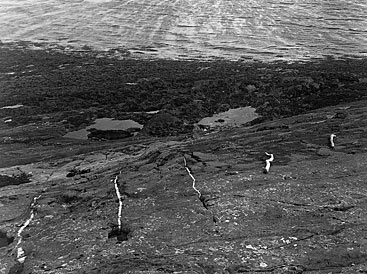
Born in 1949 in Essen (DE)
Lives and works in Essen (DE)

1988-1989
Black and white photograph, gelatin-silver print
39,5 x 50 cm
Year of Purchase: 1990
When Werner Hannappel photographs landscape in the far north or the west of France, he does so to appreciate their internal structure, the spatial order underlying informal chaos, and their sculptural aspect which is retained and revealed by the lens. No cultural mark intrudes to identify the place. The indistinctive and similar sites are captured for their formal resonance, and the far-reaching affinities which are created between elements from different scales.
In his search for virgin spaces, Hannappel constructs and composes with what he is given (branches, stones…) and what is simply there, spaces enclosed by geometric lines: these spaces filled with a grandiose and eternal solitude, with a metaphysical dimension which seems to emanate from certain ritual practices buried way back in the Stone Age. This cracked rock, a forgotten work bathed in natural light, has become an object of contemplation because of the photographic statement. Hannappel thus discovers the vocabulary and traces of the unchanging laws of nature built on layers of time and the layering of sky, water, and earth.
This sober and rigorous approach, focused on the melancholic loveliness of landscape, is based on a transcendent vision of the relations between nature and culture bequeathed by the Romantic tradition of Caspar David Friedrich. Glorified since the 1970s by Land Art artists such as Hamish Fulton and Richard Long, nature is seen as a place of creative freedom and a place of memory where the origin and essence of man’s physical and mental activity are inscribed. The approach of these artists, like that of Werner Hannappel, bears within it an existential angst associated with the growing loss of any authentic link with the natural elements.
Maïté Vissault